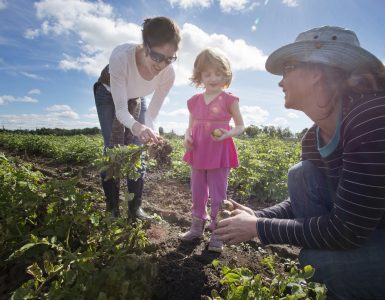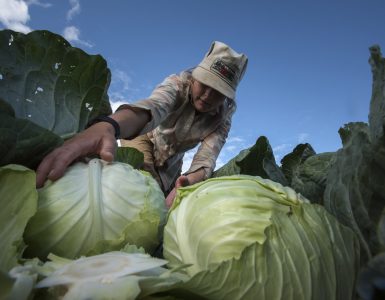This has been the most challenging growing season for tomatoes in my memory. That’s because of the rain, and a microorganism that lives in water droplets on tomato plants.
When it rains as often as it has this season—when it is cool and humid even between storms—tomato plants and other crops in the field can never dry out completely. They are always a few places for some beads of moisture to hide, maybe where two tomatoes are touching, or where a leaf curls around a trellis. These are the places that late blight can thrive.
Late blight (Phytophthora infestans in the scientific nomenclature) usually starts on the leaves. If you’re a gardener, perhaps you’ve seen this midway through summer; a few grey spots on a leaf here and there. Then a few leaves start to go brown and wither away. The blight tends to spread, affecting entire branches and then whole rows of plants. If it spreads to the fruit of the tomato, it produces a brown blister that renders the fruit unappealing and inedible.
The blight can also other crops in the tomato family—most notably the potato. Phytophthora infestans was the microorganism behind several European potato famines in the mid-1800s, including the major Irish Potato Famine during in which a million people died. (Though we should also lay the blame for that famine on aristocrats who exploited the Irish population to the point of near-starvation even before the famine began.)
The life cycle of this blight is genuinely strange. The infestation begins as a single swimming cell with two tails, which burrows into plant leaves to infect them. Once it has infected a plant, that swimming cell settles down and grows into a stationary, branching structure that looks a bit like a shrub. But instead of seeds, it grows microscopic pods full of the swimming spores, which burst out and begin the cycle again.
When scientists began to study the late blight organism in the 1800s, they had trouble classifying it. It had some characteristics of both animals (e.g., swimming) and plants (e.g., branches and “seeds”). Scientists lumped it in with the fungi; fungi weren’t plants or animals, either, and plenty of agricultural diseases are fungal.
But more recently study has found that late blight is actually part of an ancient group of organisms more closely related to kelp than fungi. No wonder it loves wet weather.
And indeed, it has been a wet year. We’ve seen record-breaking rainfall and flooding all over Ontario. It’s a strange and unnerving experience for farmers after the record-breaking drought of last year. Global warming is clearly having an impact, and we’re only seeing the beginning of the climate challenge for farmers.
Despite centuries of effort by farmers and scientists, late blight still evades most efforts to control it. Traditionally, copper sulfate has been sprayed on affected plants to try to stop the spread of blight.
Indeed, at least one potato famine in history was caused by a copper shortage. In World War I, in Germany, there was an outbreak of late blight affecting an enormous number of potatoes. But all available copper had been directed to the war effort, and none was available to make an anti-blight spray. Over 700,000 people died in the ensuing crop failure.
The reliable way to stop late blight is not through treatment, but prevention. Farmers must be careful to keep blight from infecting tomato seedlings and potato tubers. Experienced gardeners know to avoid handling tomato plants when wet, to reduce the spread of blight. Good airflow for the plants, and good soil nutrition, also help. But in such a wet year our options are limited.
A few varieties of tomatoes have been bred to be resistant to late blight. In our fields we have some plants that still look green and healthy this year. The challenge is the unpredictability of the weather in an era of worsening climate change. Should we pick our crops this spring so that they are best-suited to endure a record-breaking drought? Or record-breaking rainfall? Extreme heat, or cold? The worse climate change gets, the more difficult it will be to anticipate, and the riskier farming will become.
Aric McBay is an author and farmer.







